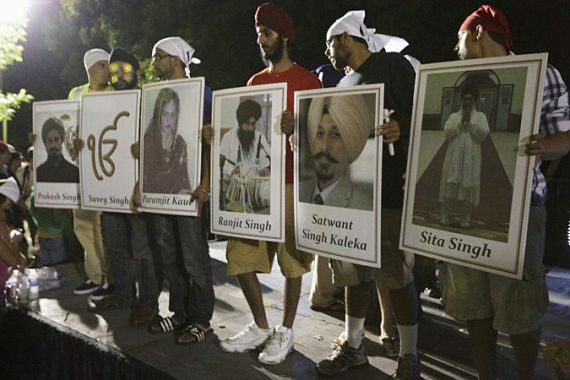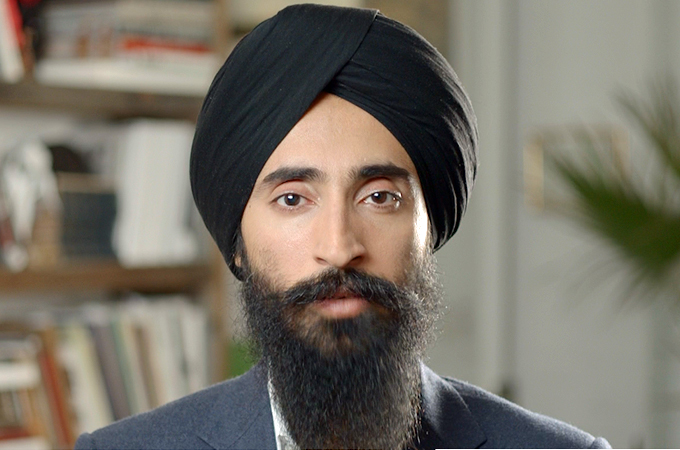US Sikhs fight racism with PR campaign
Sikhs have begun a national dialogue about identity on second anniversary of the shooting at a Sikh temple.

Wisconsin, US – Sikhs in the United States will observe the second anniversary of a deadly shooting in Oak Creek, Wisconsin on Tuesday in which a white supremacist gunman, Wade Michael Page, opened fire on a Sikh temple killing six people, including Satwant Singh Kaleka, its founder.
The August 5, 2012 attack was the deadliest on an American house of worship since the 1963 Birmingham Church bombings.
Sikhs around the world expressed outrage, but for Sikhs in the US, the sense of personal loss served as a soul searching experience as the shooting represented an assault on their identity and a turning point for many to begin defining themselves in the fabric of American life.
“My pride in being Sikh and American was very much enhanced that day, it changed my perspective on family and community,” said Kanwardeep Singh Kaleka, a nephew of the slain temple founder.
Following the shooting, he decided to adopt a Sikh appearance – not only to stand in solidarity with the Sikh community, but also to mark himself as an American “because America stands for diversity embodied by different individuals”.
“There is a silver lining from the event. People came together to learn about various faiths, which is essential in creating meaningful interactions so we can connect together as both communities and families,” he said.
Raising awareness
Other community members are raising awareness against stereotyping their community.
“The Sikh community has always been an active one, but the shooting was an unfortunate reminder that there was much to do to raise awareness about who we are,” said Harleen Kaur, 20, whose family moved from India to Racine, in southeast Wisconsin, when she was three.
The Sikh community has always been an active one, but the shooting was an unfortunate reminder that there was much to do to raise awareness about who we are.
One of two Sikh families in her hometown and the only Sikh student in her high school, Kaur told Al Jazeera that the Oak Creek Gurduwara served as a special place for her and that the killing of Kaleka turned out to be “personally impactful”.
Now an active community advocate, she adorns her articles of faith more visibly by organising youth camps in Wisconsin for the Sikh-American youth.
On a national level, several initiatives and dialogues have emerged about religious identity said Washington-based Jasjit Singh, executive director of the Sikh American Legal Defense and Education Fund (SALDEF).
SALDEF is the nation’s oldest nonprofit organisation dedicated to protecting the civil rights of Sikh Americans. In conjunction with Stanford University’s Peace and Innovation Lab, two groups conducted the first-ever national survey to assess the public perception of Sikh Americans and their articles of faith.
The Turban Myth study, published in December 2013, established that even though approximately 500,000-700,000 Sikhs live in the US, 70 percent of the American public cannot identify a picture of a Sikh man as being Sikh.
The study reported that about half of the public associates the turban with Islam, and that a culture of bias exists against the Sikh appearance of a beard, turban, and uncut hair.
“It’s not even misconception, in fact it is non-conception, as Sikhs are not even on the American radar,” Navdeep Singh, Policy Director of SALDEF, told Al Jazeera.
Using these results as a baseline to direct communal efforts and development strategy, SALDEF collaborated and partnered with Comcast to air the first of its kind Sikh American Public Service Announcement (PSA), as part of a larger campaign to introduce Sikh Americans to the American public.
Aired throughout July, the 30-second ad offers a message on the community and likens Sikh-American values to American values.
The ad – carefully scripted and evaluated by SALDEF to include specific images and facts from the Turban Myth study – meant to create consciousness among the American public to “pursue a more holistic and educated judgment of our community”, Singh said.
A monotheistic faith, Sikhism was founded in South Asia more than 500 years ago. Observant Sikhs do not cut their hair; male followers often cover their hair with turbans – considered sacred – and refrain from shaving their beards.
Ad controversy
The face of the ad, Waris Ahluwalia, a popular Sikh-American actor and designer was racially targeted with hate speech when he was featured alongside another American in a GAP ad displayed in the New York City subway in November 2013.
When SALDEF approached him about the PSA project, it immediately struck a chord in him because of his experience in creating a dialogue after the GAP ad controversy.
“I knew I wanted to participate because my work is about creating a thoughtful existence. Cultural understanding and context are some of the most powerful tools we have in the fight against ignorance and intolerance,” he told Al Jazeera.
 |
| Waris Ahluwalia says his work is about creating a thoughtful existence [Courtesy – SALDEF] |
He said the PSA can help young Sikh Americans become more cognisant of their individual potential in American society.
According to Jesse Kaur Bawa, an assistant professor of Lawyering Skills at Howard University School of Law, discrimination can only be alleviated through increased visibility.
“Not only do we have the first turbaned Sikh arguing a case in the Supreme Court, the first turban wearing female pilot, and the first turbaned Sikh on American Idol, but we also have support from government agencies,” she told Al Jazeera, while referring to an FBI announcement in June 2013, where they said they would begin to formally track hate crimes against Sikhs, Hindus, and Arabs starting in 2015.
In terms of garnering support from key governmental figures, the National Sikh Campaign hired Geoffrey Garin, former chief strategist for Hillary Clinton and strategic adviser to Priorities USA, the super PAC supporting President Barack Obama’s re-election in 2012.
A dynamic grassroots movement, the National Sikh Campaign, was formed in March with the historic mission of creating a well-evaluated and data-driven media campaign that aims at dispelling and tackling misperceptions of Sikh Americans.
“By bringing on key political consultants to form public perception on the basis of conducted organised research, our aim is to lay the foundation for the largest promotion of Sikhs in the western world,” said Gurwin Singh Ahuja, the executive director of National Sikh Campaign and former national field coordinator of Obama’s re-election campaign.
Personally motivated by the efforts of the Obama campaign and how they worked positively for a person of colour, Ahuja hopes the National Sikh Campaign can bring some constructive change for his community.
“When I saw the resources we could work with during the Obama campaign, the thought that crossed my mind was that if my community had such resources available to us, maybe Oak Creek wouldn’t have happened,” he told Al Jazeera.
With Garin spearheading their message, the campaign plans to employ social media strategies and run television ads, target web and digital integrated services and use earned media in the pursuit to singularly counter negative perceptions of Sikh Americans.
“One of my important areas of interest as a researcher has long been the topic of prejudice and understanding how to encourage people to look past negative stereotypes,” Garin told Al Jazeera.
“Given the level of bullying young Sikhs face in schools, and the ill-informed reactions people sometimes have when they see a bearded man in a turban I’m glad to have the opportunity to help the American Sikh community identify how best to communicate a more accurate and positive image to their fellow Americans.”
Anyone with a turban and a beard must be Osama bin Laden and these cases reveal that both Muslim and Sikh bigotry go hand in hand.
Mistaken for Muslims
For Ibrahim Hooper, National Communications Director for the Council on American-Islamic Relations (CAIR), the American Muslim and Sikh communities have worked closely on issues of discrimination, bias, and violence against Sikhs, where Sikhs are mistaken as Muslims by Islamophobes after the September 11, 2001 attacks.
“Anyone with a turban and a beard must be Osama bin Laden and these cases reveal that both Muslim and Sikh bigotry go hand in hand,” he told Al Jazeera describing sporadic cases where the Sikh elderly have been attacked and cab drivers have had people calling them names and thinking they are terrorists.
Michael German, a former FBI agent says there is a long and unfortunate history of white supremacist violence in this country, targeting a wide array of minority communities.
“A recent study by the Combating Terrorism Center at West Point revealed that annual fatalities caused by violence from far right extremists typically exceed those caused by other groups,” said German, who is a fellow at Brennan Center for Justice at NYU Law School and a former senior policy counsel.
“But this data should be taken in context. Only a small minority of those holding white supremacist views ever engages in violence, and the number of fatalities from politically motivated violence is still just a tiny fraction of the more than 14,000 homicides committed in this country each year,” he added.
Still, he said, the data does raise questions as to why the government tends to view politically motivated violence against minority groups, which it calls “hate crimes” differently from politically motivated violence committed by minorities, which it calls “terrorism”.
Follow Purvi Thacker on Twitter @purvi21